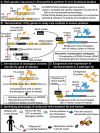The fruit fly at the interface of diagnosis and pathogenic mechanisms of rare and common human diseases
- PMID: 31227826
- PMCID: PMC6872428
- DOI: 10.1093/hmg/ddz135
The fruit fly at the interface of diagnosis and pathogenic mechanisms of rare and common human diseases
Abstract
Drosophila melanogaster is a unique, powerful genetic model organism for studying a broad range of biological questions. Human studies that probe the genetic causes of rare and undiagnosed diseases using massive-parallel sequencing often require complementary gene function studies to determine if and how rare variants affect gene function. These studies also provide inroads to disease mechanisms and therapeutic targets. In this review we discuss strategies for functional studies of rare human variants in Drosophila. We focus on our experience in establishing a Drosophila core of the Model Organisms Screening Center for the Undiagnosed Diseases Network (UDN) and concurrent fly studies with other large genomic rare disease research efforts such as the Centers for Mendelian Genomics. We outline four major strategies that use the latest technology in fly genetics to understand the impact of human variants on gene function. We also mention general concepts in probing disease mechanisms, therapeutics and using rare disease to understand common diseases. Drosophila is and will continue to be a fundamental genetic model to identify new disease-causing variants, pathogenic mechanisms and drugs that will impact medicine.
© The Author(s) 2019. Published by Oxford University Press. All rights reserved. For Permissions, please email: journals.permissions@oup.com.
Figures

References
-
- Lee T. (2017) Wiring the Drosophila brain with individually tailored neural lineages. Curr. Biol., 27, R77–R82. - PubMed
-
- Robie A.A., Hirokawa J., Edwards A.W., Umayam L.A., Lee A., Phillips M.L., Card G.M., Korff W., Rubin G.M., Simpson J.H. et al. (2017) Mapping the neural substrates of behavior. Cell, 170, 393–406e328. - PubMed
-
- Posey J.E., O’Donnell-Luria A.H., Chong J.X., Harel T., Jhangiani S.N., Coban Akdemir Z.H., Buyske S., Pehlivan D., Carvalho C.M.B., Baxter S. et al. (2019) Insights into genetics, human biology and disease gleaned from family based genomic studies. Genet. Med., 21, 798–812. (https://www.ncbi.nlm.nih.gov/pubmed/30655598). - PMC - PubMed
Publication types
MeSH terms
Grants and funding
LinkOut - more resources
Full Text Sources
Medical
Molecular Biology Databases

